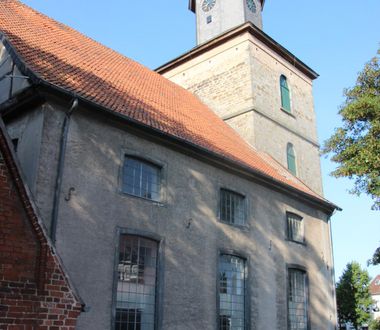Hoya / Weser - County seat on the Weser
Between fields, forest and meadows in the municipality of Hoyerhagen lies, according to official calculations, the geographical centre of the state of Lower Saxony. As a marker, a stone specially made by a sculptor was placed there to indicate the exact point to all visitors. Guests who visit the point can get a certificate in Hoya.
Hoya/Weser for friends of fairy tales
The 800-year-old county seat is often described as “legendary”. This can be experienced on one of the many guided tours. You can set out with shepherd Henry and his retinue on an enchanting moonlight tour through the old town or listen to castle whisperings in the Earl’s castle. Also the dwarfs who celebrated in the castle can be seen in person as well as along the Long Street as sculptures.
Every year on the third weekend in September, Hoya, with its historical Katharina Market, is set back into the time of the old Count of Hoya. Conjurers, musicians, and noble ladies and lords hasten from all parts of the former Imperial County of Hoya. Stalls are built up round about the old church and the citizen's park where merchants and craftsmen hawk their goods.
The Dwarf Christmas in Hoya's old town is also held on the second Advent weekend.
The well-known dwarf's legend “The Count of Hoya” is already recounted in the German legends of the Brothers Grimm. The Grimm's version goes back to an old source from the end of the 16th century.
Additional legends from the Hoya the joint municipality also deal with the sprite Hinzelmann in Eystrup, the construction of the church for Hoyerhagen, poltergeists in the parsonage of Hoyerhagen, a golden spinning wheel on the Kolkhof in the former mill in Hilgermissen, the foundation of the Collegiate Church at Bücken, and the golden barrel in the wasteland at Bücken.
Hoya/Weser for holiday tourists and day visitors
There are regional bicycle paths through the Hoya joint municipalities and along the Weser (Grafen-Ring, Achtertour, ALLERhand am WESERstrand among others), which in part underscore local legends and stories. The Grafen-Ring, for instance, leads to the showplace of the dwarf legend located on the eastern side of the Weser. The castle was built as a water keep of the Count of Hoya. The east and west wing of the former fortifications are built on a ground plan whose core still reverts to the Middle Ages; the free-standing middle building was built in the 19th century.
Hoya’s old town is furthermore shaped by the historical city hall, the Von Behr Manor as well as the 900-year-old Grafenkirche church, which today is called the Kulturzentrum Martinskirche (Martin Church Cultural Centre) and is used for weddings as well as cultural events.
Peacefully located on the Weser (5 minutes walking distance to the town centre), the motorhome overnight parking area “Weserblick” invites you to linger in the county seat.
The widely visible double-towered legendary Stiftskirche (Collegiate Church) of Bücken harks from the foundation of Archbishop Rimbert of Bremen (865-888). The impressive church construction was built in four stages between the 11th and 14th century, and was comprehensively restored in the 19th century. Noteworthy are the rich interior furnishings: a large Late Gothic carved altar (around 1510), sacrament house (around 1500), stone pulpit (13th century), triumph cross (1230), choir stalls (around 1340), glass paintings (before 1250).

